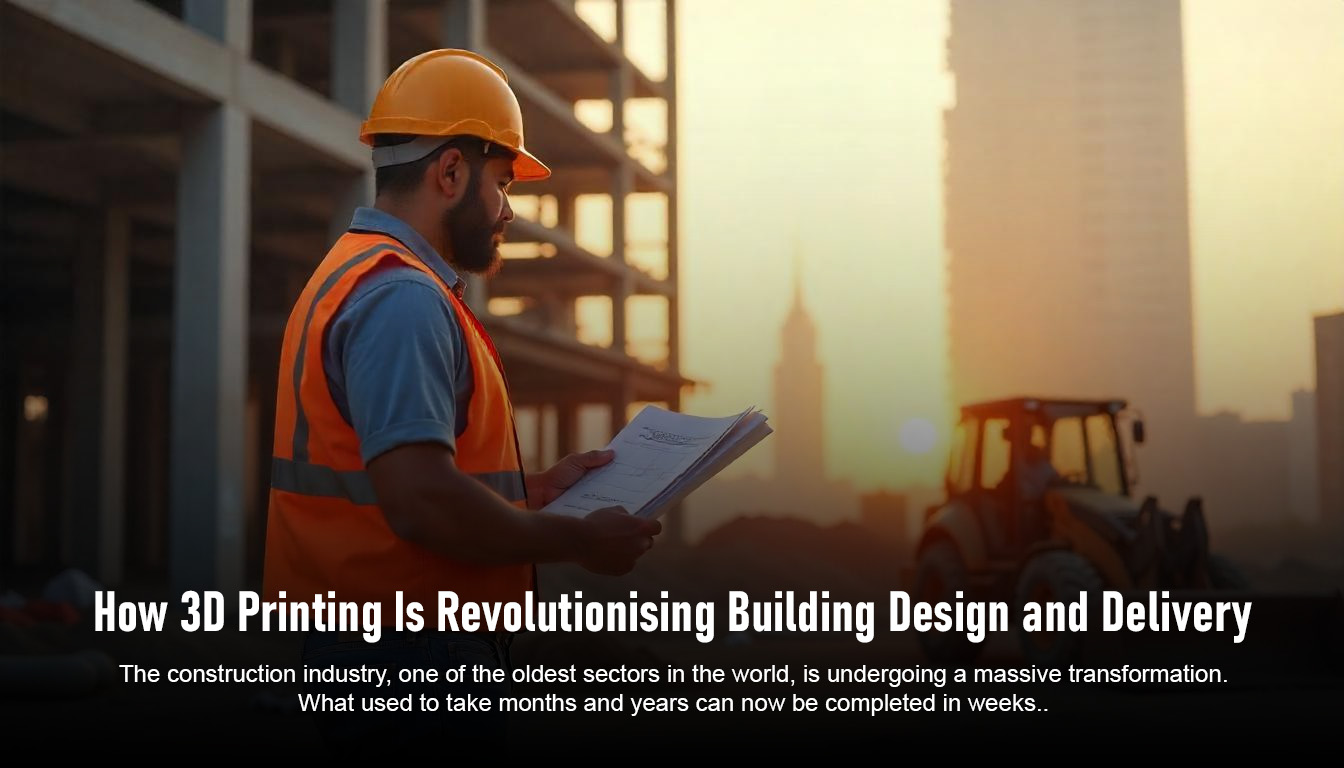The construction industry, one of the oldest sectors in the world, is undergoing a massive transformation. What used to take months and years can now be completed in weeks, thanks to 3D printing in construction. From designing complex structures to delivering cost-effective homes, 3D printing is reshaping how we think about buildings.
In this article, we’ll explore how this technology is not just futuristic it’s already changing the way buildings are designed, constructed, and experienced.

The Rise of 3D Printing in Construction
3D printing construction technology, also known as additive manufacturing in construction, involves layering materials like concrete, plastic, or composites to create building components or entire structures. Unlike traditional construction methods that rely on subtracting or assembling materials, this approach builds layer by layer, offering precision, speed, and flexibility.
Some key applications include:
- 3D printed buildings and 3D printed homes
- 3D printing architecture for custom design elements
- 3D concrete printing for structural and decorative parts
- 3D printing in civil engineering for infrastructure projects
Case in Point:
In Mexico, a project by New Story and ICON built 3D printed houses for underprivileged families. The homes were affordable, sturdy, and completed in a fraction of the usual time.
Technology & Methods Behind the Magic
To understand how 3D printing building design is possible, it helps to know the core technologies involved:
1. Concrete 3D Printing Technology
Specialised printers use a quick-setting concrete mix, allowing them to build walls and structural parts rapidly.
2. Construction 3D Printing Methods
Methods vary from on-site printing to prefabrication in factories. Printers can build entire homes on location or create 3D printing building components for later assembly.
3. 3D Printing Construction Equipment
These printers can be robotic arms or gantry-based machines. Automation is key for consistent quality and faster output.
4. 3D Printing Construction Process
A digital model guides the machine, ensuring accurate replication of design specs. From concept to structure, the process is streamlined and efficient.
Also Read: Commercial Construction Estimation: The Big Picture
Sustainability & Efficiency
A major reason 3D printing in construction is gaining popularity is its potential to make the industry more eco-friendly.
Environmental Benefits:
- Sustainable construction with 3D printing reduces material waste.
- It supports green building practices by using recycled materials.
- Energy-efficient 3D printed buildings help in lowering electricity and heating costs.
- Reducing construction waste with 3D printing contributes to a smaller carbon footprint.
- Projects can even aim for LEED certification thanks to their minimal environmental impact.
Example:
In Dubai, the world’s largest 3D printed building is used as a government office. It used 60% less waste and 50% fewer laborers.
Cost & Time Advantages
3D printing is not only about innovation; it’s also about being smart with resources.
Key Benefits:
- Cost-effective 3D printing construction uses less material and labor.
- Time-saving construction methods complete projects faster than traditional techniques.
- 3D printing for rapid construction is perfect for urgent housing needs.
- 3D printing reduces construction time by automating repetitive tasks.
- Helps in labor cost reduction by minimising human involvement.
- Affordable 3D printed homes can be a game-changer in housing markets.
- Ideal for emergency shelters and disaster relief housing due to its speed.
Example:
In China, a company built 10 3D printed houses in under 24 hours, demonstrating the scale at which this technology can operate.
Real-World Applications & Case Studies
3D printing has gone from experimental to operational in many parts of the world. Here’s where it’s making a real difference:
1. 3D Printed Houses Case Studies
Projects in the U.S., Europe, and Asia are already selling or renting 3D printed homes.
2. 3D Printing in Residential and Commercial Construction
Residential homes, office buildings, and even schools are now being printed.
3. 3D Printed Bridges Examples
In the Netherlands and China, pedestrian bridges have been 3D printed using metal and concrete.
4. 3D Printing in Urban and Rural Housing
It provides scalable solutions for both dense urban areas and underdeveloped rural zones.
5. 3D Printing in Developing Countries
Countries with housing shortages can benefit from this affordable, quick method.
6. 3D Printing in Architectural Design
Complex curves and shapes that would be costly or impossible using traditional methods are now easily achievable.
Industry Trends & Future Outlook
The future of 3D printing in construction looks bright as technology continues to evolve.
Trends to Watch:
- Innovations in 3D printing technology are making machines smaller, smarter, and more affordable.
- 3D printing in smart cities allows for more efficient infrastructure.
- Modular construction using printed parts improves scalability.
- Robotics in 3D printing construction enhances precision and reduces error.
- 3D printing in space construction is already being tested by NASA.
- Governments are working on 3D printing and building codes to standardise the practice.
- Construction workforce is being retrained to operate and manage 3D systems.
Long-Tail Insight: Specific Benefits and Challenges
While 3D printing has clear benefits, it’s important to understand the full picture.
Benefits:
- How 3D printing is changing building design by enabling custom, flexible layouts.
- 3D printing for custom architectural designs eliminates the need for expensive moulds.
- 3D printing in sustainable urban development brings eco-homes to life.
- 3D printing in construction project management reduces delays and increases transparency.
- 3D printing and BIM integration allows seamless digital to physical execution.
- It also helps optimise the construction supply chain by reducing inventory needs.
Challenges:
- Challenges of 3D printing in the building industry include regulatory issues, high initial investment, and lack of skilled workers.
- Comparatively, 3D printing vs traditional construction methods still sees gaps in scalability for high-rise or very large buildings.
Final Thoughts
As the construction industry faces rising material costs, labor shortages, and a need for more sustainable methods, 3D construction printing offers a compelling solution. With its ability to build faster, cheaper, and greener, it’s not just a passing trend it’s the foundation of a new era.
Whether you’re a civil engineer, architect, developer, or policymaker, it’s time to pay attention. 3D printing in construction isn’t just changing how we build it’s changing what’s possible to build.
